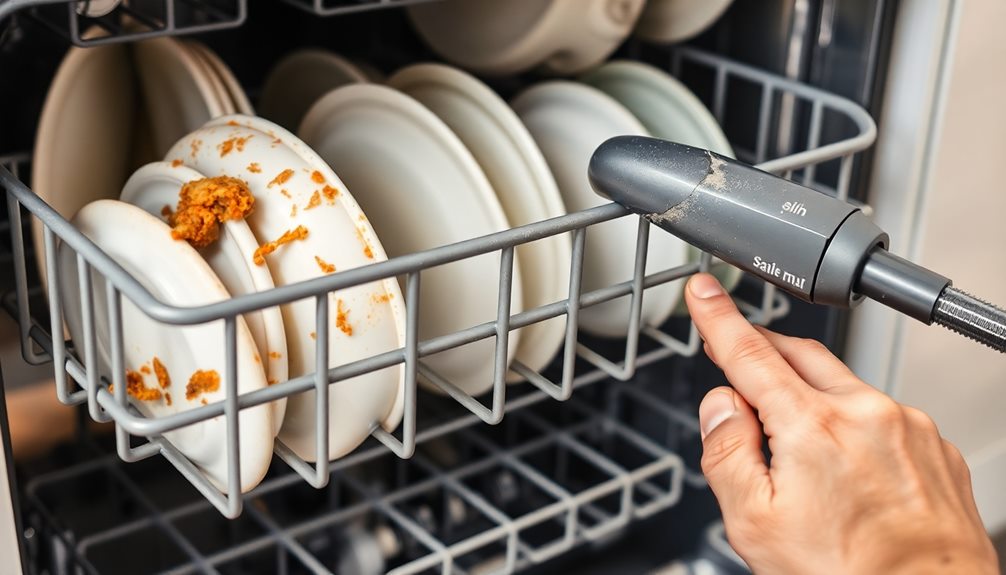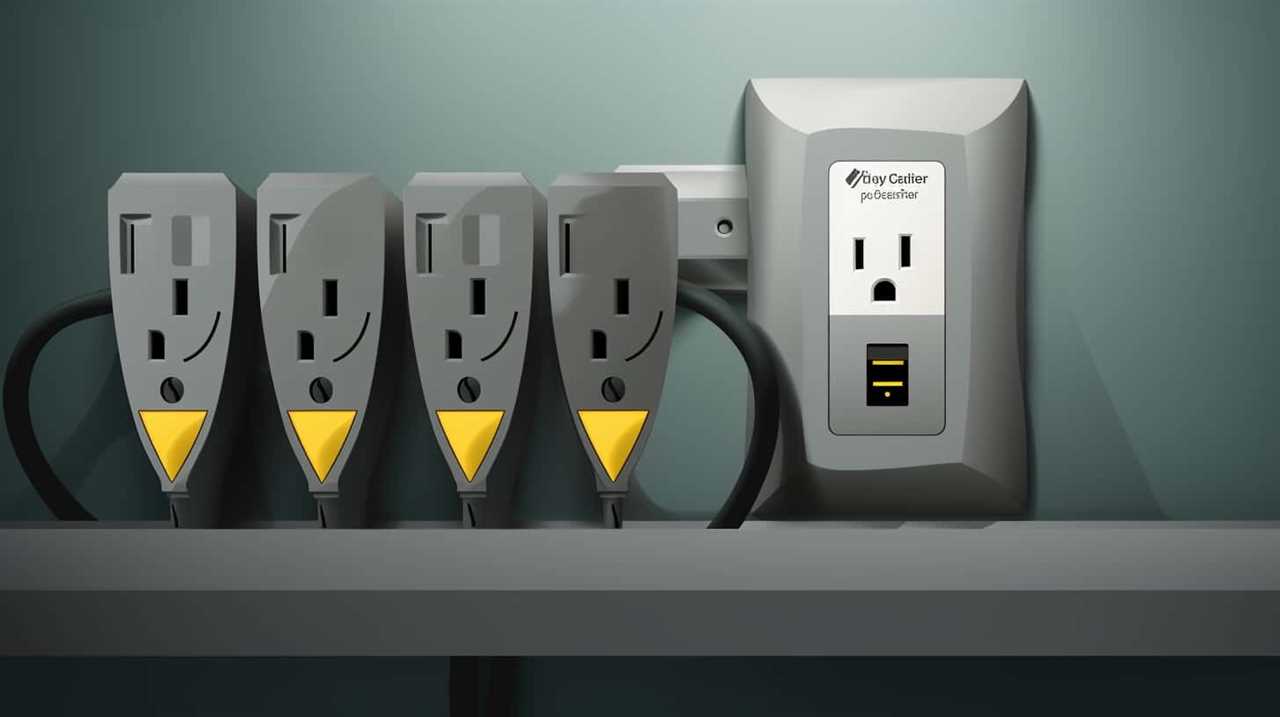If your top rack isn't cleaning properly, it's usually caused by blocked spray arms, improper loading, or clogged filters. Start by checking for obstructions inside the spray arms and verify larger items don't block the water flow. Also, inspect and clean your dishwasher's filter to promote better water circulation. Make sure water pressure is adequate and that you're loading dishes correctly—larger items belong on the bottom rack. Regular maintenance, like cleaning the spray arms and filters, can also help prevent these issues. Stick around to discover more helpful tips and potential solutions for a sparkling clean dishwasher!
Key Takeaways
- Check for blocked spray arms and clear any obstructions to ensure effective water reach on the top rack.
- Ensure proper loading by placing larger items on the bottom rack to avoid blocking the upper spray arm.
- Regularly clean the filter at the bottom of the dishwasher to prevent clogging and maintain water flow.
- Inspect and maintain the spray arms by removing mineral buildup and ensuring they rotate freely.
- Verify that the water supply valve is fully open and the minimum water temperature is at least 120°F (49°C).
Common Causes of Top Rack Issues

When you notice the top rack of your dishwasher isn't cleaning dishes properly, there are a few common culprits to contemplate. One significant issue could be blocked spray arms. If your upper spray arm is obstructed, water can't reach your top rack dishes effectively, resulting in poor cleaning performance.
Improper loading can also cause problems. If you place larger items on the upper rack, they may block the spray arm's movement, hindering water flow and leaving your top rack dishes dirty.
Additionally, clogged filters or mineral buildup from hard water can restrict water flow, further diminishing the cleaning capability of your dishwasher.
Regular maintenance is crucial to prevent these issues. Make certain to clean the spray arms frequently and check for any obstructions that could impede their rotation.
Water Pressure Problems
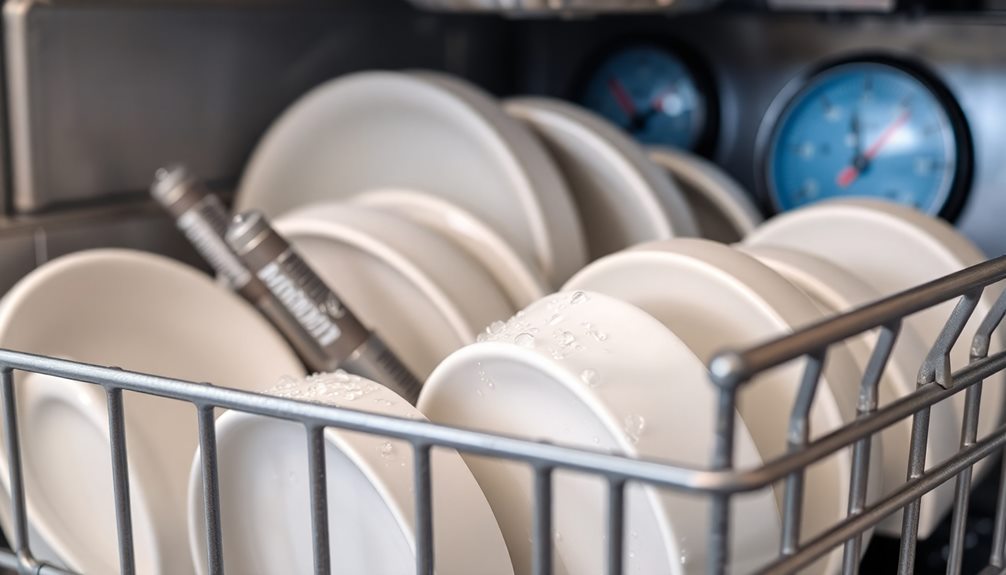
Low water pressure can create significant challenges for your dishwasher, particularly affecting the top rack's cleaning efficiency. When the water pressure is low, your dishes may come out dirty, leaving you frustrated after a wash cycle.
To tackle this issue, first, check that your water supply valve is fully open. If it's not, you might be restricting water flow to your dishwasher.
Next, inspect the supply line for any kinks or blockages that could be impeding water flow. Running your dishwasher when no other water-consuming appliances are in use can also help maintain higher water pressure during the wash cycle, ensuring better cleaning results.
Keep in mind that a minimum water temperature of 120°F (49°C) is needed for effective cleaning. Low water pressure may affect the performance of your water heater, which can further complicate matters.
If you've made adjustments and low water pressure persists, it could indicate underlying plumbing problems. In such cases, you should consider consulting a professional to evaluate your plumbing and restore adequate flow, ultimately enhancing the cleaning of your top rack.
Importance of Proper Loading

When loading your dishwasher, correct dish placement is key to achieving a thorough clean.
You need to avoid overcrowding the racks to guarantee free spray motion, allowing water to reach every surface effectively.
Correct Dish Placement
Proper dish placement in your dishwasher is vital for achieving spotless results. To maximize cleaning efficiency, always load your dishes facing downward. This allows the water to reach all surfaces and minimizes blockages.
It's important to place larger items on the bottom rack, as they can obstruct the movement of the upper spray arms, hindering their ability to clean the top rack effectively.
Avoid an overloaded dishwasher, as overcrowding can restrict water circulation and lead to poor cleaning results. Confirm there's sufficient space between dishes to allow water to flow freely.
Additionally, utilize designated slots for utensils to maximize space and prevent them from nesting together. When utensils are packed too closely, it can restrict water flow and impact cleaning efficiency.
Lastly, always refer to your dishwasher's manufacturer guidelines for loading instructions specific to your model. Following these recommendations can enhance cleaning results and help prevent potential damage or malfunctions.
Avoid Overloading Racks
Overloading racks can severely compromise your dishwasher's cleaning performance, negating the benefits of correct dish placement. When you overload the dishwasher, you restrict water jets, preventing thorough cleaning of your dishes on both the top and bottom racks. This can lead to unsatisfactory results, leaving food particles behind.
To enhance cleaning efficiency, always place larger items on the bottom rack. This prevents them from obstructing the upper spray arm, allowing for better water circulation. Dishes should be spaced adequately, with enough gaps between them to guarantee water and detergent can reach all surfaces.
Avoid nesting items like stacking bowls or plates, as this can trap food particles and block water flow, resulting in dirty dishes after a wash cycle.
If you've got a lot of dirty dishes, consider running two separate loads instead of one overloaded cycle. This strategy considerably boosts cleaning performance, guaranteeing all items receive proper water exposure and detergent distribution.
Ensure Free Spray Motion
Guaranteeing free spray motion is vital for achieving ideal cleaning results in your dishwasher. To maximize the cleaning performance of the top rack, place your dishes with the dirty side facing down. This positioning allows water to flow effectively and reach all surfaces.
Be mindful of larger items; they can block the spray arms, hindering their unobstructed rotation and coverage during the wash cycle. Leave enough space between dishes to enable water and detergent to circulate freely. This space is critical for effective cleaning, as overcrowded racks can restrict movement and diminish the spray arms' efficiency.
Overloading the dishwasher not only affects the top rack but can also lead to unsatisfactory results overall. Regularly check that the upper rack is properly aligned and that spray arms are securely attached. Any misalignment can create resistance, further reducing cleaning performance.
Maintaining Spray Arms
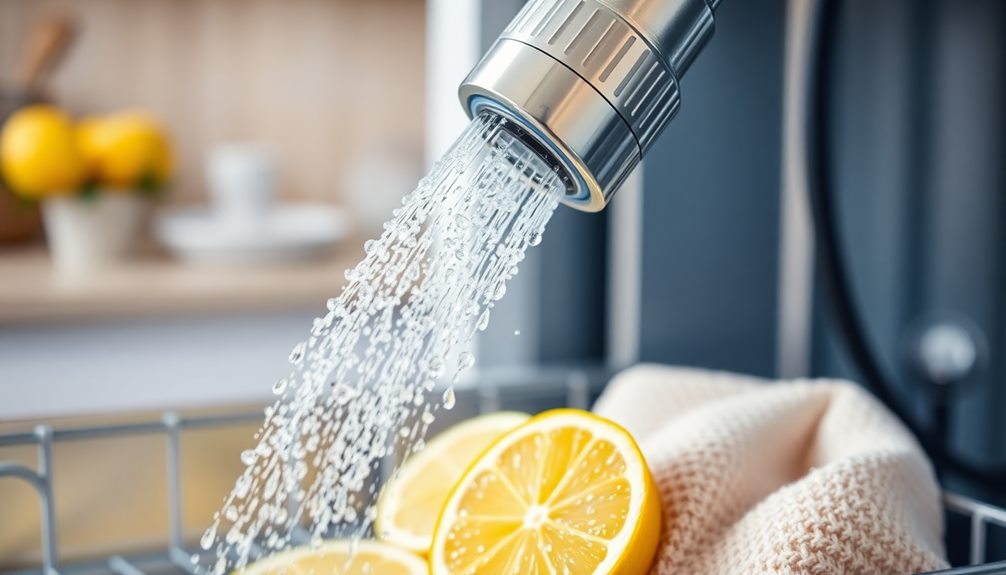
To keep your dishwasher running smoothly, regularly inspect the spray arms for blockages.
Cleaning and soaking them in a vinegar solution can help remove stubborn mineral deposits.
Plus, make sure they're properly aligned so they can rotate freely and distribute water effectively.
Inspect for Blockages
When maintaining your dishwasher, it's vital to regularly inspect the upper spray arm for any blockages. Food particles and mineral buildup can hinder cleaning efficiency, leading to unsatisfactory results.
Start by detaching the upper spray arm to check for visible obstructions. Use a thin brush or toothpick to clear any clogging in the spray arm holes. This guarantees water can flow freely during the wash cycle.
After removing the spray arm, take a close look at its connecting parts as well. Sometimes, debris can accumulate there, causing further issues. Be vigilant and inspect for blockages in both the spray arm and its connectors.
If you notice significant mineral deposits, consider using a mixture of vinegar and warm water to soak the spray arm. This can effectively dissolve stubborn buildup, enhancing performance.
Once you've cleaned everything, it's important to confirm that the spray arm is properly reattached. Misalignment can prevent it from rotating and distributing water effectively.
Clean and Soak
After checking for blockages in the upper spray arm, it's time to give it a thorough clean.
Start by carefully removing the spray arm to inspect for any visible obstructions or food particles that could obstruct water flow.
Once you've got it off, prepare a solution of warm water and vinegar, or CLR, and let the spray arm components soak for at least 30 minutes. This soaking will help dissolve any mineral buildup and clogs effectively.
After soaking, grab a soft brush or a thin tool like a toothpick to gently clean out any remaining deposits from the spray arm holes. This step is essential to guarantee that water can flow freely when you run your dishwasher.
Once you've cleaned everything, make sure to securely reattach the spray arm, ensuring it can spin freely.
Before you run a test cycle, check that everything is in place.
Regularly schedule maintenance checks every few months to clean the spray arms and prevent future blockages, keeping your dishwasher running efficiently.
A clean spray arm is key for effective cleaning performance in the top rack!
Ensure Proper Alignment
Maintaining your dishwasher's upper spray arm alignment is essential for ideal cleaning performance. If the upper spray arm isn't securely attached, it can become misaligned, which prevents water from reaching your dishes. This can lead to poor cleaning results, especially on the top rack.
To guarantee proper alignment, follow these steps:
- Regularly inspect the connection points of the upper spray arm to make sure it's seated correctly.
- Check that the spray arm rotates freely without any obstruction.
- Ascertain no large items on the bottom rack are blocked, as they can hinder water flow to the upper spray arm.
If you notice that the spray arm is damaged or worn, replacing it with a compatible part can restore its proper alignment and improve cleaning efficiency.
Keeping these factors in mind will help you maintain the effectiveness of your dishwasher, ensuring every cycle delivers the best possible results.
Don't overlook the importance of the upper spray arm—it's key to keeping your dishes sparkling clean!
Troubleshooting Blocked Spray Arms
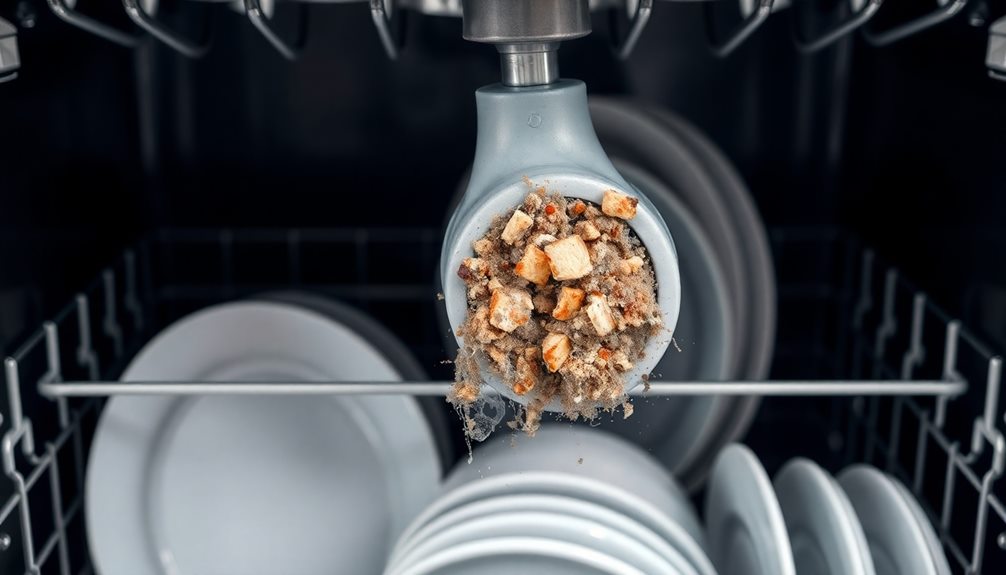
Effective cleaning in your dishwasher hinges on the unobstructed flow of water, and blocked spray arms can considerably compromise this process.
If you're struggling to clean the top rack, it's essential to inspect these spray arms for any visible obstructions. Food particles or mineral buildup can prevent water and detergent from reaching your dishes effectively.
Start by removing the spray arm from your dishwasher. Look closely at the holes; if they're clogged, you won't achieve proper cleaning.
To tackle this, soak the spray arm in vinegar or a descaling solution like CLR. This will help dissolve any mineral deposits that might be hindering water flow.
Next, use a thin brush or toothpick to gently clean out the spray arm holes, ensuring they're free from debris.
Once you've thoroughly cleaned the spray arms, reattach them and run a test cycle. Pay attention to whether the spray arm rotates freely.
If it does, you should notice an improvement in your dishwasher's overall cleaning performance.
Checking for Clogged Filters
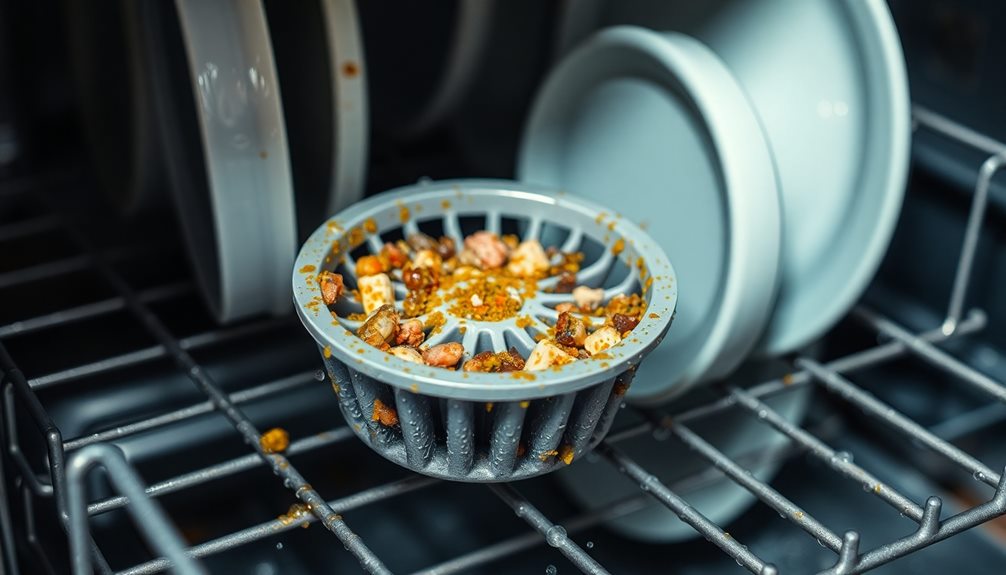
Clarity in your dishwasher's performance often hinges on the cleanliness of its filters. Clogged filters can restrict water flow, leading to poor cleaning efficiency and leaving you with dirty dishes.
It's crucial to check and clean your dishwasher's filters regularly, as food particles and debris tend to accumulate over time.
Here are some steps to help you verify your filters are in top shape:
- Locate the filter: Most dishwashers have a removable filter at the bottom. Consult your owner's manual for specific instructions on accessing it.
- Soak the filter: If you notice stubborn residues, soak the filter in warm soapy water to help dissolve the buildup before rinsing it thoroughly.
- Reinstall and test: After cleaning, reinstall the filter and run a short cycle to check if your top rack is performing better.
Signs of a Malfunctioning Dishwasher

After ensuring your dishwasher's filters are clean, it's time to pay attention to the signs that could indicate a malfunctioning appliance.
If your dishes on the top rack remain dirty after a wash cycle, the upper spray arm might be blocked or malfunctioning, preventing proper water flow. Look for soap residue left in the dispenser; this can suggest issues with water pressure or spray arm performance.
Inconsistent cleaning results, especially on the upper rack, often point to obstructions in the spray arms or a clogged filter that restricts water flow.
You should also listen for any unusual noises during operation, as these can signal mechanical problems, such as a failing wash motor or misaligned spray arms that decrease efficiency.
Tips for Preventive Maintenance
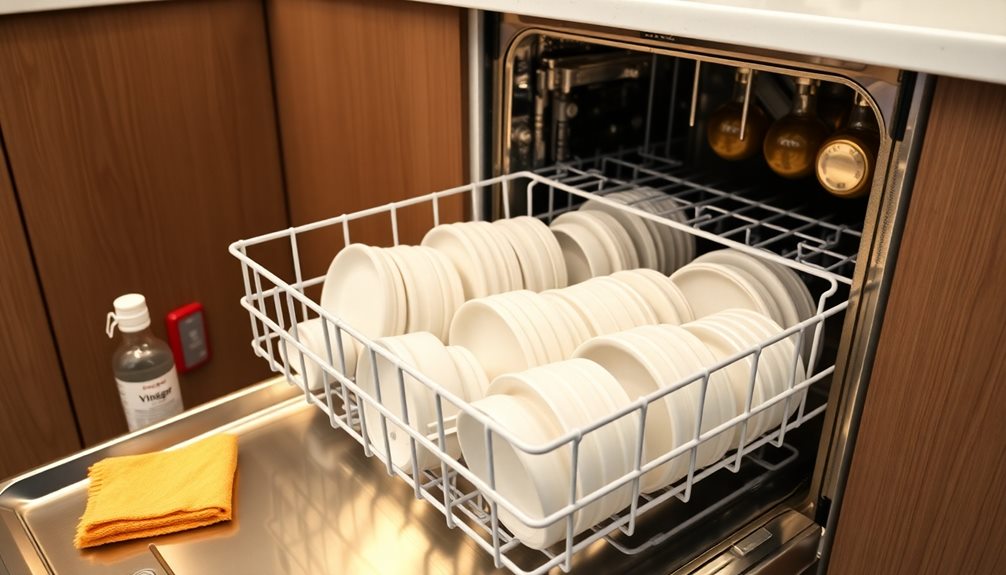
To keep your dishwasher running smoothly, make certain you regularly clean the spray arms and filters.
Proper loading techniques can also improve cleaning efficiency, so take a moment to load your dishes correctly.
Don't forget to schedule monthly maintenance checks to catch any potential issues early and guarantee peak performance.
Regular Spray Arm Cleaning
While regular maintenance might seem tedious, cleaning the spray arms of your dishwasher is essential for guaranteeing efficiency and maximum cleaning performance. A clogged upper spray arm can greatly reduce water flow, leading to poor cleaning results.
To keep your dishwasher in top shape, follow these tips for regular spray arm cleaning:
- Inspect monthly: Remove the spray arms and check for clogs or debris that might hinder water flow. Regular maintenance is key to avoiding issues, similar to how robot vacuum cleaners automate cleaning tasks and enhance home hygiene.
- Clear blockages: Use heavy-duty wire or paperclips to clean out any blocked holes. Even small obstructions can affect performance.
- Descale regularly: Soak the spray arm components in warm water and vinegar or a descaling agent like Lime Away to dissolve mineral buildup caused by hard water.
After cleaning, manually rotate the spray arms to verify they spin freely. This guarantees prime water distribution during operation.
Additionally, schedule routine maintenance checks for all dishwasher components, including filters and seals, to extend your appliance's lifespan and maintain effective cleaning performance.
Taking these steps will help you avoid issues with your dishwasher's top rack and keep everything sparkling clean!
Proper Loading Techniques
Loading your dishwasher correctly is just as important as keeping it clean. To maximize your cleaning efficiency, always load dishes facing downward on the top rack. This positioning guarantees that the upper spray arm can effectively reach all surfaces without any obstructions.
Avoid placing tall or bulky items on the top rack, as they can block the spray arm's rotation, leading to inadequate cleaning.
Utilize the designated slots for utensils, and make certain there's sufficient space between items. Proper loading techniques promote better water circulation during the wash cycle, allowing for a more thorough clean.
Remember, it's better to run two separate loads than to overload the dishwasher. Too many dishes can hinder the cleaning efficiency, leaving you with unsatisfactory results.
After each wash, take a moment to check and adjust your loading arrangement. Identifying and correcting any patterns that may lead to poor cleaning results can greatly improve your dishwasher's performance.
Monthly Maintenance Checks
Even with proper loading techniques in place, your dishwasher still needs regular maintenance to keep it running effectively. Monthly inspections and routine cleaning can help you prevent common causes of poor performance, guaranteeing your dishes come out sparkling clean.
Here are some essential monthly maintenance checks to perform:
- Inspect and clean the spray arms to make sure they're free from clogs and can rotate smoothly for effective cleaning.
- Clean the dishwasher filters to prevent debris buildup that restricts water flow, which can lead to subpar cleaning results.
- Run a cleaning cycle with vinegar or a specialized dishwasher cleaner to eliminate mineral deposits and buildup inside the machine.
Additionally, check and clean the door seals and gaskets for any damage or debris, ensuring a proper seal and preventing leaks.
Don't forget to regularly check the water heater setting, adjusting it to maintain a temperature of at least 120°F (49°C) for ideal cleaning efficiency.
When to Call a Professional

Knowing when to call a professional for dishwasher cleaning issues can save you time and prevent further damage. If you've tried troubleshooting and persistent problems remain, it might indicate malfunction requiring professional assistance. Pay attention to unusual noises during operation, as these can signal mechanical problems that need a technician's expertise.
Here's a quick reference table to help you decide:
| Issue | Potential Cause | Action |
|---|---|---|
| Persistent cleaning issues | Malfunction requiring inspection | Call a technician |
| Unusual noises | Mechanical problems | Schedule evaluation |
| Water pooling | Drainage issues | Get professional help |
| Inconsistent results | Complex repairs needed | Request inspection |
| Worn-out parts | Aging components | Seek maintenance |
If you notice water pooling at the bottom, it's critical to address this drainage issue with professional help. Inconsistent cleaning results over multiple cycles may require an expert's inspection to identify complex repairs beyond basic maintenance. Trusting professionals can help extend your dishwasher's lifespan, ensuring it operates efficiently.
User Experiences and Recommendations
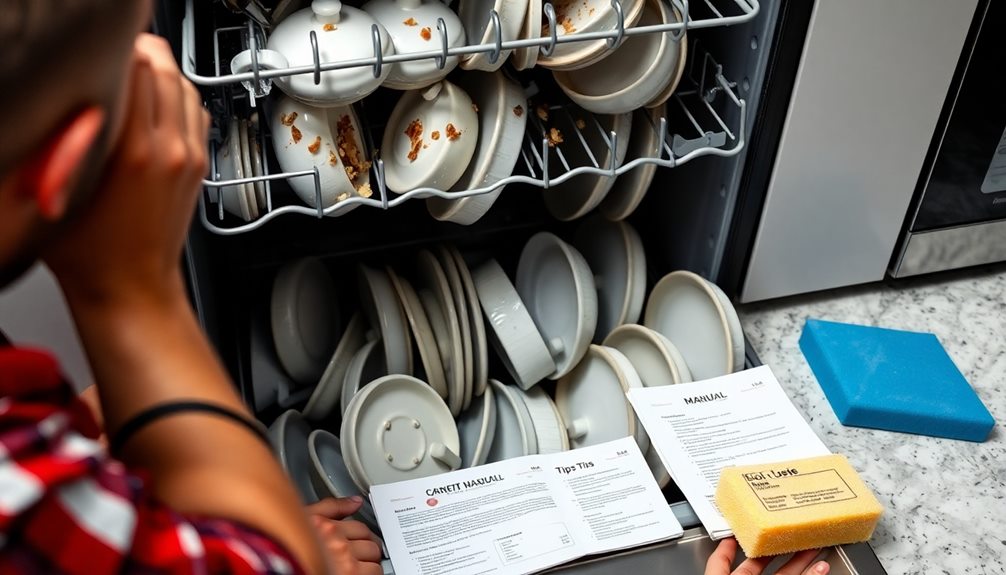
Many users have shared valuable experiences that can enhance your dishwasher's performance. One common tip is to regularly clean the upper spray arm, as blocked holes can greatly hinder water flow, impacting the cleaning efficiency of the upper rack.
Here are some key recommendations from users:
- Place larger items on the bottom rack: This prevents obstruction of the spray arms, guaranteeing that the upper rack gets adequate water flow.
- Run a cleaning cycle with vinegar: This helps eliminate mineral buildup, improving the function of the spray arms and enhancing overall cleaning performance.
- Check water temperature: Confirming it reaches a minimum of 120°F (49°C) is essential for effective cleaning, so take a moment to verify before starting a cycle.
Additionally, users advise against overloading your dishwasher. Providing enough space between items allows for better water circulation, which is vital for cleaning all dishes effectively.
Frequently Asked Questions
Why Is the Top Shelf of My Dishwasher Not Cleaning?
The top shelf of your dishwasher might not clean due to blocked spray arms, low water pressure, improper loading, clogged holes, or insufficient water temperature. Check these factors to improve cleaning performance effectively.
Why Is My Dishwasher Leaving Food Residue on Top Rack?
Your dishwasher's leaving food residue on the top rack like a stubborn artist refusing to clean up! Check for blocked spray arms, improper loading, low water pressure, or clogged holes to restore its dazzling performance.
Why Is the Top Sprayer on the Dishwasher Not Working?
If the top sprayer isn't working, check for blockages, make certain it's aligned correctly, and verify water pressure. Overloading can also hinder its function, so load items properly for peak cleaning performance. Regular maintenance helps too!
How Does a Dishwasher Clean the Top Rack?
A dishwasher cleans the top rack by using rotating spray arms that distribute water and detergent. It relies on proper water temperature and pressure, ensuring thorough cleaning when you load items correctly and maintain the machine.
Conclusion
To sum up, if your top rack's not cleaning, don't let it leave you in a lurch! By checking water pressure, loading properly, and maintaining those spray arms, you can keep your dishwasher running smoothly. Remember, a little preventive care goes a long way in avoiding bigger headaches down the line. If all else fails, don't hesitate to call a professional—sometimes, it's best to get a helping hand when the going gets tough!
